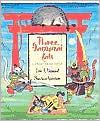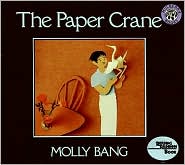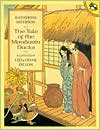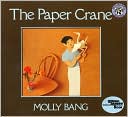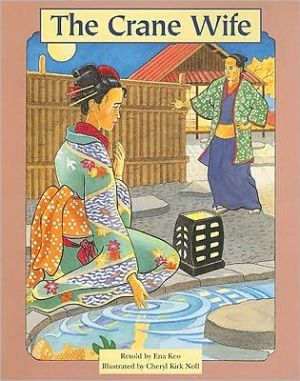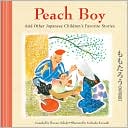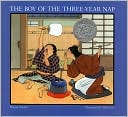Three Samurai Cats: A Story from Japan
Search in google:
An adaptation of a Japanese folktale in which a feudal lord seeks a samurai cat to rid his castle of a savage rat, but soon discovers that violence is not always the best way ...Publishers WeeklyPlenty of action enlivens this team's (The Jar of Fools: Eight Hanukkah Stories from Chelm) version of a Zen parable about a castle held hostage by a gluttonous rat. The castle daimyo (powerful lord), a bulldog in a medieval Japanese costume, requests helpers from a shrine famous for its corps of fighting samurai cats. The rat defeats the first two candidates handily. Watch! proclaims the second, in the manner of martial arts heroes, I will demonstrate the technique of karigane, the wild goose, followed by shimo-tatewari, the bottom vertical split; the swish of his sword is almost audible, but his artistry is wasted when the rat boots him across the room. Gerstein uses Japanese anime style panels, but not their flat figures; his animals have heft, bulk and plenty of untidy fur. He has great fun with the paunchy rat, who alternately terrorizes the good guys and eats himself silly. At last the shrine sends Neko Roshi, the Zen master cat, a mangy but patient animal who waits for the rat's inevitable misstep and exploits it; the rat, threatened at last, leaves quietly. Neko Roshi allowed his opponent to defeat himself, explains the head of the fighting cats, when the daimyo comes to express amazement: Learn to act without acting. Children may not fully understand the cat's paradoxical tactics, or the mystical Zen message, but the sense is clear enough. Humor, wisdom and excitement make this offbeat tale a winner. Ages 5-8. (Apr.) Copyright 2003 Reed Business Information.
\ Publishers WeeklyPlenty of action enlivens this team's (The Jar of Fools: Eight Hanukkah Stories from Chelm) version of a Zen parable about a castle held hostage by a gluttonous rat. The castle daimyo (powerful lord), a bulldog in a medieval Japanese costume, requests helpers from a shrine famous for its corps of fighting samurai cats. The rat defeats the first two candidates handily. Watch! proclaims the second, in the manner of martial arts heroes, I will demonstrate the technique of karigane, the wild goose, followed by shimo-tatewari, the bottom vertical split; the swish of his sword is almost audible, but his artistry is wasted when the rat boots him across the room. Gerstein uses Japanese anime style panels, but not their flat figures; his animals have heft, bulk and plenty of untidy fur. He has great fun with the paunchy rat, who alternately terrorizes the good guys and eats himself silly. At last the shrine sends Neko Roshi, the Zen master cat, a mangy but patient animal who waits for the rat's inevitable misstep and exploits it; the rat, threatened at last, leaves quietly. Neko Roshi allowed his opponent to defeat himself, explains the head of the fighting cats, when the daimyo comes to express amazement: Learn to act without acting. Children may not fully understand the cat's paradoxical tactics, or the mystical Zen message, but the sense is clear enough. Humor, wisdom and excitement make this offbeat tale a winner. Ages 5-8. (Apr.) Copyright 2003 Reed Business Information.\ \ \ \ \ Children's LiteratureA huge rat has taken over the castle of a powerful daimyo. The rat laughs at traps, ignores poison, and attacks the guard dogs. The desperate daimyo rides his horse to the monastery to ask the docho for help. The docho agrees to send a samurai cat. The rat quickly outwits him and the humiliated cat leaves. Another bigger cat is then sent. He is also defeated. Upon hearing the third request for help, the docho says he will send Neko Roshi. The diamyo cannot believe that this ragged, old decrepit cat was sent to save him. Neko Roshi lies about on a mat eating and resting, as the rat becomes bolder and meaner. When the court is preparing rice balls for the Obon Festival, the greedy rat takes all of the balls from the tray and forms them into one large rice ball, which he then proceeds to roll away. As he is passing Neko Roshi, he becomes stuck under the huge mass of rice and cannot move. Neko Roshi agrees to help him only if he will leave the castle. The rat agrees and leaves. This story reflects Buddhist traditions of stillness, meditation, and harmony with nature. The rat defeats himself. Delightful, action-filled illustrations feature the daimyo and his court as dogs. The docho and the monks are also canines. A good source for inspiring thoughtful discussions about different ways to solve problems. 2003, Holiday House,\ \ \ School Library JournalK-Gr 3-Here's an adaptation of an adaptation of a story Zen masters used to illustrate how unconventional approaches to problems can be disarmingly effective. When a daimyo's castle is besieged by an enormous, ferocious rat, the lord beseeches the abbot of a nearby monastery to send a samurai cat to drive the beast away. The first and second samurai to confront him are overwhelmed by the rodent's martial-arts skills, but the third, a tattered, disreputable-looking old feline, allows the rat's greed to work against him and emerges triumphant. Kimmel's telling is reasonably successful and the message to "Draw strength from stillness. Learn to act without acting. And never underestimate a samurai cat-" is conveyed without any element of preachiness. Gerstein's lively cartoon illustrations are at their best in depicting the loathsome rat. The daimyo and the abbot are depicted as dogs, but there's no question as to who has the upper paw.-Miriam Lang Budin, Chappaqua Public Library, NY Copyright 2003 Reed Business Information.\ \ \ \ \ Kirkus ReviewsZen stories are difficult for the uninitiated to grasp and this adaptation of a Japanese folktale by prolific reteller Kimmel is no exception. The thoughtful reader may gain some insight into the quiet workings of a Zen master's teachings. Others may simply enjoy the humorous pictures of the dogs and cats in medieval Japanese costumes, who enliven Gerstein's panels in this comic book-like format, without quite understanding the point of the story. A daimyo, a powerful lord in the shape of a large canine, begs the chief monk cat at a faraway shrine to find a solution to his trying problem: a rat trying to eat him out of house and home. Two vigorous young samurai cats arrive, fight, and fail. The third samurai cat, ragged and old, uses nonviolence to trick the rat into leaving of his own accord. A sophisticated story designed to stimulate unconventional thinking. (author's note) (Picture book/folklore. 6-9)\ \
